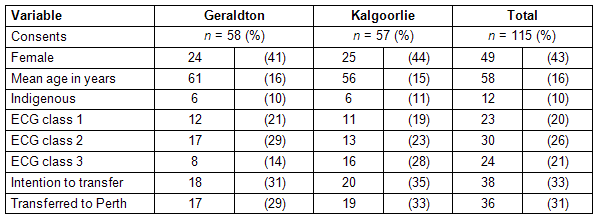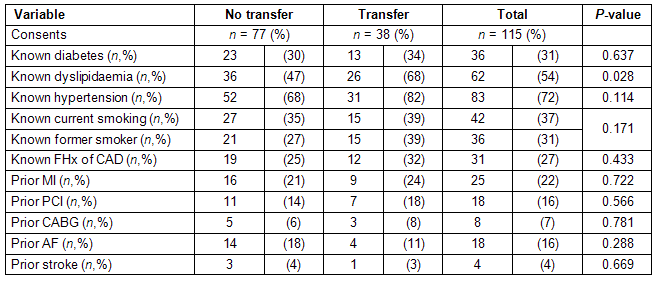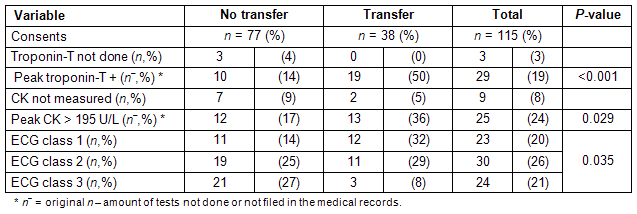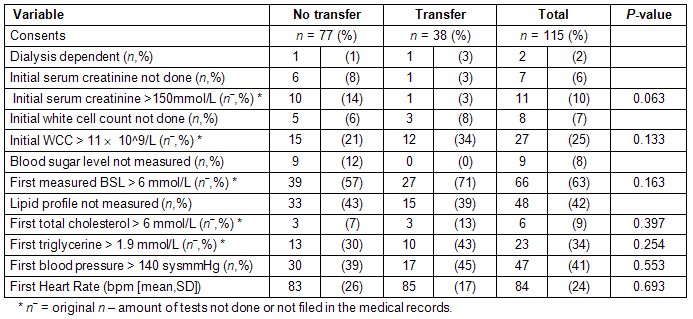Introduction
Coronary heart disease is the largest single cause of death in Australia1. Cardiovascular diseases contribute 18% to the total burden in disability-adjusted life years (DALYs) and accounted for 47,637 deaths in 2004 in Australia2,3 and 36% of deaths in Western Australia (WA)4. Overall Australian death rates rise with increasing remoteness, with circulatory diseases as the leading cause5. This is possibly due to worse socioeconomic factors (higher prevalence of smoking and obesity) and impaired access to health care.
In WA, invasive treatments for acute coronary syndromes (ACS) are only available in the metropolitan hospitals of Perth. Patients admitted to rural clinics have to be transferred if they need invasive cardiac care. For patients with suspected ACS every hour counts; medical guidelines6 and scientific papers7-11 emphasize the importance of (early) recognition of ACS, by both patient (community) and medical staff, in order to effectively implement proven therapies and optimize patient outcomes12. Early invasive therapy and in-hospital revascularization leads to better survival rates of patients with a suspected ST-elevation myocardial infarction (STEMI), but also for those with a non ST-elevation ACS13,14.
The ability of rural medical staff to accurately determine which patient with chest pain is likely to have ACS and needs to be transferred for invasive treatment in a metropolitan hospital, is crucial in the medical process. This study explored chest pain management in rural WA hospitals to determine if it agrees with Australian guidelines for the management of ACS15.
Methods
Background
There are just over 2,000,000 citizens in WA and they are spread over 2,550,000 square kilometres16. Approximately 1,550,000 people live in the metropolitan area of Perth. The capital contains hospitals with many specialists, whereas large rural hospitals only have specialized emergency departments.
Two large rural centres are stationed in Geraldton and Kalgoorlie. Together they provide health care for approximately 100 000 people in the Midwest and Goldfields Region (an area of more than 1 million km2), including a relatively high Aboriginal population16. These centres also act as the intermediate centres for transfers from even smaller clinics to Perth. Acute patients are transferred on airplanes; depending on the urgency of needed care, patients' transfer times differ.
Patient population
The recently finalized Australian Acute Coronary Syndrome Prospective Audit (ACACIA)7,17 registry gathered data of 3402 ACS Australian patients. Chew et al. found that major preventable risk factors for cardiovascular disease1 and in-hospital measurements were independent predictors of hospital mortality of acute coronary events18. A simplified version of this method17,19 was used to gather retrospective data at the Geraldton Regional Hospital and the Kalgoorlie Hospital.
Consenting patients, 18 years or older, who presented to the emergency department (ED) from January to May of 2008, complaining of chest pain (CP) and who could either have left the hospital that same day or stayed as in-patient for longer were selected for the study. Patients were asked to participate either prior to discharge or when called after discharge.
Exclusion criteria were ACS accompanied or precipitated by significant co-morbidity (eg motor vehicle accidents, trauma, severe gastrointestinal bleeding or peri-procedural MI).
These selection criteria were translated by a medical researcher (BB) to major diagnostic categories (MDCs) and Australian Triage Scale scores (ATS).
- The MDCs are mutually exclusive groups based on principal diagnosis; MDC-5, diseases and disorders of the circulatory system, was included in the study.
- Triaging is a systematic assessment determining patient's priority at ED arrival. Patients with triage scores 1-3, conditions that require a response of assessment within 30 minutes or less, were included.
Recruitment modalities
Patients' medical record numbers (MRNs) were selected and medical records were checked if patients fitted the selection criteria.
Of all these patients data were first registered of those who, during their in-hospital stay:
- were transferred to Perth
- had had a proven myocardium infarction.
Overlapping occurred because some transferred patients had an MI during their in-hospital stay.
Then, expanding the control group, the study aimed for twice as many non-transferred as transferred patients at each study site. Over a nine-week period from March till May 2008, all patients fitting the profile were selected.
Data collected
The data for these patients are summarised in Table 1.
Table 1: Data for patients included in the study

A cardiologist divided all electrocardiograms into four classes:
- Class 1 - persistent ST-elevation > 1 mm in ≥2 contiguous leads, or new/presumed new left bundle branch block.
- Class 2 - ST-depression > 0.5 mm, or T-wave inversion in >2 contiguous leads.
- Class 3 - Q-waves or ST/T changes in ≥2 leads.
- Class 4 - other, not necessarily normal ECG.
The outcome measure was a patient's transfer or not (discharge from the rural hospital), which shows the doctors' interpretation of patients' symptoms. If doctors intended to transfer a patient, but the patient requested not to be, the outcome was registered as 'transfer'.
Statistical analysis
The χ2 test was used to compare the single factors. If tests were 'not done' only registered tests could be compared.
Independent sample t-tests were used to compare means.
Univariate and multivariate logistic-regression analyses (stepwise backwards procedure) were used to determine which binary factors were likely to influence the transfer-outcome. Analyses were conducted with SPSS15 (SPSS; www.spps.com).
Results
Over 50 consents were obtained at each site. Of the 115 enrolled patients (mean age of 58 years), 36 (31%) were transferred to Perth. Table 2 lists further characteristics.
Table 2: Patient characteristics, by site

The patients were separated in two groups: those who were meant to be transferred (transfer) and those who were not (no transfer). At each site one patient requested not to be transferred, despite doctor's advice; these two patients were included in the transfer group.
Initially χ2 tests and independent sample t-tests were used to compare patient groups on relevant socio-demographic and medical characteristics. Tables 3 to 6 show these results (if blood tests were missing, percentages were calculated over the number of known test results: n-).
Table 3: Demographic patient characteristics and p-values, by transfer status

Table 4: Social-medical history determinants and p-values according to transfer status

Table 5: Cardiac biomarkers and first ECGs of patients with chest pain, p-values by transfer status

Table 6: In-hospital measurements and p-values according to transfer status

Neither the mean age nor the number of indigenous patients differed between transfer groups. More men than women presented with chest pain and were transferred, hence, there was no significant difference between genders.
Histories of cardiovascular diseases, high blood pressure, diabetes and smoking were not significant, nor was family history for coronary artery disease. Known history of dyslipaedemia was different between transfer groups (p-value was 0.028).
A positive peak troponin-T was measured in 19 (50%) transferred and 10 (14%) non-transferred patients. Of the transferred patients, 13 (36%) had high peak creatine kinase (CK) levels compared with 12 (17%) non-transferred patients. The ECGs of 12 (32%) transferred and 11 (14%) non-transferred patients were suspected for STEMI. All three determinants were significant in chi-squared tests.
Dialysis dependency, increased serum creatinine, high white cell count, high blood sugar level, high lipid profiles, high blood pressure and increased heart rate were not significant.
According to binary-logistics, patients with a positive peak troponin-T were more likely to be transferred (6.40; 95% CI, 2.55-16.08). In all multivariable models, troponin-T remained significant.
Peak troponin-T was a confounder for both ECG and peak CK; these variables lost significance when adjusted for peak troponin-T. A known history of dyslipidaemia remained significant and serum creatinine became significant.
The stepwise backwards procedure was used to search for all determinants that remain or become significant when adjusted for each other in a regression model.
Gender and serum creatinine, which were not significant predictors on their own, became significant when taken into account with troponin-T and known dyslipidaemia. All four factors had significant increased or decreased odds when adjusted for each other (Table 7).
Table 7: Multivariate regression model, all 4 determinants adjusted for the other 3

Patients with a positive peak troponin-T were 27.61 times more likely to be transferred and those with known dyslipidaemia 3.25 times more likely (95% CI, 6.41-199.04 resp.1.12-9.44). Men had a 2.92 times higher chance of being referred to a metropolitan hospital than women (95% CI, 1.00-8.55). High serum creatinine decreased odds of transfer (OR0.01; 95% CI, 00-0.15).
Discussion
Main findings
A positive peak troponin-T gives increased the chances of transfer, but ECG and CK do not when adjusted for peak troponin-T. Known dyslipidaemia increased and high serum creatinine decreased the chance of transfer. Men were more likely to be transferred than women.
Limitations of this study
The study represents patients who had given their consent. However not all patients who fitted the selection criteria were reached. Patients and patient information may have been missed because hospital visits had not been filed properly. Furthermore, a short time was available for this trial and only 115 patients were enrolled. Due to the small transfer groups, the 95% confidence intervals were large.
Comparison with other studies
The results of this study do not agree with the finding of Chew et al.17 that patients with suspected STEMI are strongly associated with invasive management during their in-hospital stay. This service is not available rural WA. Might one assume that more patients would have been referred, if rural hospitals provided invasive cardiac care? Scott et al.20, who observed routine care of ACS in Australia, state that admission to tertiary hospitals increases chance of referral to early coronary angiography.
Known dyslipidaemia appears to increase odds of transfer, probably because high cholesterol increases the risk of coronary heart disease21.
Although the catchment area of Kalgoorlie has more men than women, the influence of gender cannot only be attributed to patient demographics. The treatment of men is approached more aggressively than of women; their chest pain is more often recognized, diagnosed and treated22,23.
In the ACACIA registry results, distance to invasive services does not appear to negatively impact upon events for Australian ACS patients24. Rural patients with suspected ACS were only enrolled in their study if they were transferred to a study hospital less than 12 hours after initial presentation, whereas this trial detected many patients transferred after more than 12 hours or not transferred at all. This worsens the outcome for ACS patients in rural WA.
Transfer rates for both patients with chronic heart failure and those presenting with acute coronary syndromes appear to be lower in rural areas than in urban areas25,26. The prevalence of chronic heart diseases is higher among people living outside capital cities27 and rural death rates are also higher28.
How to proceed?
Changes in ECG, and troponin-T and CK levels are the main signs of a present acute coronary syndrome15. Although many electrocardiograms were faxed to and discussed with cardiologists in Perth, rural clinics have missed suspected STEMIs, indicating that skills in reading electrocardiograms could be improved. Many rural WA patients have cardiac risk factors that indicate a need to reduce preventable risk factors. This study was too small to make a definitive comment on the quality of care provided for patients with ACS in rural Western Australia. It has, however, raised significant questions that should be explored through larger studies.
Acknowledgements
Special thanks are extended to Dr JHA Janssen and Dr EF van Beeck for supervising Dr BM Blokker during her research. Thanks also to the Medical Directors of the Geraldton Regional Hospital and the Kalgoorlie Hospital, Dr F Moss and Dr P Barrett, for providing accommodation and access to medical records. Thanks to Dr R Moorin, Director of Health Science Studies and ACERH for providing access to SPSS at the University of Western Australia.
References
1. Australian Institute of Health and Welfare. Heart, stroke and vascular diseases, Australian Facts: 2004. AIHW Catalogue no. CVD 27. Canberra: AIHW and Heart Foundation of Australia (Cardiovascular Disease Series No. 22), 2004a. Available: www.aihw.gov.au/publications/index.cfm/title/10005 (12 August 2010).
2. Australian Bureau of Statistics. Self-assessed Health in Australia: A Snapshot, 2004-05. (Online 2005). Available: http://www.abs.gov.au/ausstats/abs@.nsf/mf/4828.0.55.001
3. Department of Health, Government of Western Australia. Population health in perspective in Western Australia. Available: http://www.health.wa.gov.au/publications/documents/HO8.pdf (Accessed 12 August 2010).
4. Vos T, Begg S. The burden of cardiovascular disease in Australia for the year 2003. Melbourne, Vic: Heart Foundation, 2007.
5. Australian Institute of Health and Welfare. Rural, regional and remote health - Indicators of health. (Online) 2005. Available: http://www.aihw.gov.au/publications/phe/rrrh-ihsdh/rrrh-ihsdh.pdf (Accessed 12 August 2010).
6. Antman EM, Anbe DT, Armstrong PW, Bates ER, Green LA, Hand M et al. ACC/AHA guidelines for the management of patients with ST-elevation myocardial infarction - executive summary: a report of the American College of Cardiology/American Heart Association Task Force on Practice Guidelines (writing committee to revise the 1999 guidelines for the management of patients with acute myocardial infarction). Circulation 2004; 110(4): 588-636.
7. Chew DPB, Allan RM, Aroney CN, Sheerin NJ. National data elements for the clinical management of acute coronary syndromes. Medical Journal of Australia 2005; 183(9): S5-7, S14.
8. Finn JC, Bett JHN, Shilton TR, Cunningham C, Thompson PL on behalf of the National Heart Foundation of Australia Chest Pain Every Minute Counts Working Group. Patient delay in responding to symptoms of possible heart attack: can we reduce time to care? Medical Journal of Australia 2007; 187(5): 293-298.
9. Pope JH, Aufderheide TP, Ruthazer R, Woolard RH, Feldman JA, Beshansky JR et al. Missed diagnoses of acute cardiac ischemia in the emergency department. The New England Journal of Medicine 2000; 342(16): 1163-1170
10. Hand M, Brown C, Horan M, Simons-Morton D. Access to timely and optimal care of patients with acute coronary syndromes - community planning considerations: A Report by the National Heart Attack Alert Program. Journal of Thrombosis and Thrombolysis 1998; 6: 19-46.
11. Trevi G, Sheiban I, Gorni R. Elements conditioning the severity of myocardial infarction damage. Cardiologia 1994; 39(12 Suppl 1): 181-186 (In Italian).
12. Boersma E, Maas ACP, Deckers JW, Simoons ML. Early thrombolytic treatment in acute myocardial infarction: reappraisal of the golden hour. The Lancet 1996; 348: 771-775.
13. Bavry AA, Kumbhani DJ, Rassi AN, Bhatt DL, Askari AT. Benefit of early invasive therapy in acute coronary syndromes: a meta-analysis of contemporary randomized clinical trials. Journal of the American College of Cardiology 2006; 48(7): 1319-1325.
14. Yan AT, Yan RT, Tan M, Eagle KA, Granger CB, Dabbous OH et al. Canadian Acute Coronary Syndromes (ACS) Registry Investigators. In-hospital revascularization and one-year outcome of acute coronary syndrome patients stratified by the GRACE Risk Score. American Journal of Cardiology 2005; 96(7): 913-916.
15. Acute Coronary Syndrome Guidelines Working Group. National Heart Foundation of Australia Cardiac Society of Australia and New Zealand. Guidelines for the management of acute coronary syndromes. Medical Journal of Australia 2006; 184(8): S1-S30.
16. Government of Western Australia, Department of Health: WA Country Health Service. Australian Bureau of Statistics: 2006 Census Community Profile Series. (Online) 2006. Available: http://www.wacountry.health.wa.gov.au (8 November 2007).
17. Chew DP, Amerena JV, Coverdale SG, Rankin JM, Astley CM, Soman A et al, on behalf of the ACACIA investigators. Invasive management and late clinical outcomes in contemporary Australian management of acute coronary syndromes: observations from the ACACIA registry. Medical Journal of Australia 2008; 188(12): 691-697.
18. Granger CB, Goldberg RJ, Dabbous O, Pieper KS, Eagle KA, Cannon CP et al. Predictors of hospital mortality in the global registry of acute coronary events. Archives of Internal Medicine 2003; 163: 2345-2353.
19. Chew DP, Amerena JV, Coverdale SG, Rankin JM, Astley CM, Brieger DB. Current management of acute coronary syndromes in Australia: observations from the acute coronary syndromes prospective audit. Internal Medicine Journal 2007; 37(11): 741-748.
20. Scott IA, Derhy PH, O'Kane D, Lindsay KA, Atherton JJ, Jones MA for the CPIC Cardiac Collaborative. Discordance between level of risk and intensity of evidence-based treatment in patients with acute coronary syndromes. Medical Journal of Australia 2007; 187(3): 153-159.
21. Prospective Studies Collaboration, Lewington S, Whitlock G, Clarke R, Sherliker P, Emberson J, Halsey J et al. Blood cholesterol and vascular mortality by age, sex, and blood pressure: a meta-analysis of individual data from 61 prospective studies with 55,000 vascular deaths. Lancet 2007; 370(9602): 1829-1839.
22. Lehmann JB, Wehner PS, Lehmann CU, Savory LM. Gender bias in the evaluation of chest pain in the emergency department. American Journal of Cardiology 1996; 77(8): 641-644.
23. Vaccarino V, Rathore SS, Wenger NK, Frederick PD, Abramson JL, Barron HV et al. Sex and racial differences in the management of acute myocardial infarction. New England Journal of Medicine 2005; 353: 671-682.
24. Coverdale S, Breiger D, Amerena J, Rankin J, Astley C , Soman A et al. Distance and invasive services for acute coronary syndromes in Australia: observations from the Acute Coronary Syndrome prospective audit. In: Proceedings, CSANZ 2007 55th Annual Scientific Meeting; 9-12 August; Christchurch, NZ. 2007.
25. Walters DL, Aroney CN, Chew DP, Bungey L, Coverdale SG, Allan R et al. Variations in the application of cardiac care in Australia. Medical Journal of Australia 2008; 188(4): 218-223.
26. Clark RA, Eckert KA, Stewart S, Phillips SM, Yallop JJ, Tonkin AM et al. Rural and urban differentials in primary care management of chronic heart failure: new data from the CASE study. Medical Journal of Australia 2007; 186(9): 441-445.
27. Clark RA, McLennan S, Eckert K, Dawson A, Wilkinson D, Stewart S. Chronic heart failure beyond city limits. Rural Remote Health 5: 443. (Online) 2005. Available: www.rrh.org.au (Accessed 12 August 2010).
28. Sexton PT, Sexton TH. Excess coronary mortality among Australian men and women living outside the capital city statistical divisions. Medical Journal of Australia 2000; 172: 370-374.
